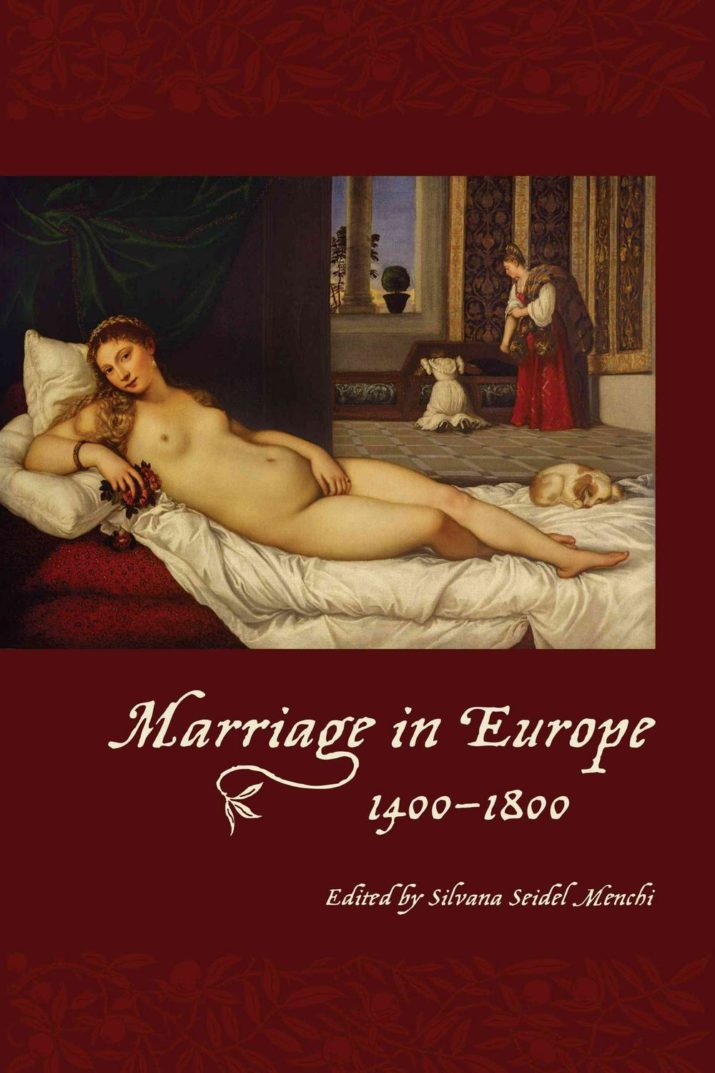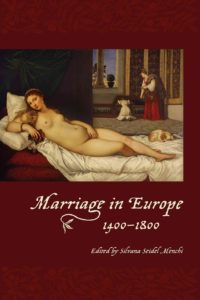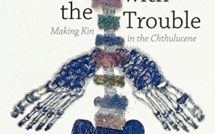

Collections of essays are sometimes uneven, but no such weakness plagues Marriage in Europe. The editor has solicited contributions from an impressive array of leading scholars in the field, and from eight different countries. Seidel Menchi describes them as “crossers of frontiers,” not merely the frontiers between nations but of the frontier “that separates the sphere of norms, doctrines, and laws from the sphere of day-to-day experience” (7). She has gathered them together in seminars not once but three times (2004, 2006, 2008), allowing them to learn of and react to each other. And she has exercised active editorial control and contributed, for her part, not just the obligatory editorial introduction but her own paper about “marital experiments” and a concise conclusion. The result is a “must read” volume for anyone interested in marriage and family life in the period.
The controlling theme of the volume is that “the model of a disciplined, regulated, socially conforming marriage as formulated by jurists and theologians, found itself in competition with a variegated and undisciplined category of marriage, obeying individual impulses and emotions” (7). The eruption onto the European stage of Protestantism, while it notably changed some of the official language and institutions of marriage—including for Catholics in the wake of the decree Tametsi of the Council of Trent—only served to shift the lines which “undisciplined” marriage had to cross. The various essays address that issue within the confines of differing countries or Europe as a whole, arranged under three broad headings.
The excellent opening chapter belongs to Charles Donahue, Jr., who investigates the European legal context to set the stage (which the editor also bookends with her contribution, placed last, on “experiments” that ran counter to and challenged the legal regimen of marriage that Donahue lays out). Law set the conditions for a valid marriage (evidence of consent, absence of impediments or dispensation from them) and the rule that, once legally established, a marriage was indissoluble. This minimal medieval heritage was redirected in the Reformation, so that parental consent was demanded and clerical officiating was required to preclude the clandestine marriages that had clogged ecclesiastical court dockets. Protestantism also allowed limited forms of divorce, chiefly for adultery and abuse or abandonment. Catholicism did not allow divorce and had no foundational role for parental consent, although Trent required clerical presence and a period of prior announcement of bans, so at least parents would be informed of marital intent. Marriage remained part of the sacramental apparatus of the Church. Donahue nonetheless argues for the substantial continuity of marriage law, despite Protestantism and Trent, based on a reading of jurisprudential sources.
Those whose essays follow in the first section of the book find much the same sort of continuity in court actions and social practices, although legal business moved away from proving whether a marriage existed to determining whether a betrothal did. Certainly Heide Wunder’s essay on Germany, Daniela Lombardi‛s on Italy, and Richard Helmholz‛s on England all unearth persisting patterns. Wunder, for example, acknowledges Luther‛s “path-breaking” sense of humans as sexual beings (68), yet in tracing marriage law up to the era of codifications in the eighteenth and nineteenth centuries found that social and economic factors remained dominant. Lombardi perceptively poses the question when did persons in fact attain recognition as husband or wife—to themselves and to their community. People perceived marriage as “a profoundly religious event” (98), even if they did not avail themselves of church services, except for those of church courts to resolve (or mediate the resolution of) conflicts. Yet they did not peg their identities to the events that mattered to the Church. She finds that “pre-Tridentine canonical norms left the laity ample space to conduct their family lives as they saw fit” (101). Population mobility also generated opportunities for bigamous unions, as there was space not only for expression of affection but of more practical pooling of resources and needs. Following Trent, then, Italian marital disputes, mainly brought by women, shifted to issues of betrothal and sought to salvage their honor and reputation in the face of an unfulfilled marital promise, while in other cases that meant initiating marital co-habitation without benefit of church blessing.
For England the situation created by the Reformation there paradoxically left ecclesiastical courts in a pre-Tridentine condition, as they continued to operate without benefit of canon law reforms. Secularization of marriage in England was a decidedly slow process. Clandestine marriage was still possible, and there were few cases of divorce. Helmholz finds that suits alleging clandestine marriage declined in number, possibly because they became harder to win, as such marriages were increasingly deemed disreputable. Evidentiary rules also became tougher.
Following on the first section‛s theme of change and continuity, the second section addresses licit and illicit in marital and sexual behavior. Manon van der Heijden examines the Low Countries, where Protestant law in 1580 attempted to remove marital jurisdiction to the state, but the Dutch courts kept pre-Reformation patterns, such as the emphasis on binding consent in contrast to a church ceremony. Consistories were intent on forging reconciliations of erring faithful with the church, as many still took up with a spouse without clerical blessing. Premarital sex, on the other hand, came in for increasing disfavor by clergy and laity alike.
Susanna Burghartz uses the notion of social order to explain the disciplining of premarital sex in Germany and Switzerland. Reformers’ hopes to establish marriage as a way of life for all, yet held to a paragon of sexual purity, privileged, for a time, sexual order over social order. Courts in search of moral order became more oppressive, but behavior continued to concern setting social and economic conditions, a gender and generational order, and the logic of social honor. Ordinances punishing pre-marital sex by engaged couples faced sometimes vehement resistance. In a similar manner, Jesús M. Usunáriz traces the Spanish church‛s attempts with the unique collaboration of the monarchy to propagate and enforce publicity of bans, parental consent, and its own jurisdiction against the still valid pattern of consent followed by sexual relations that characterized clandestine marriages. Marriages in fact were largely under paternal control, but court records disclose interesting instances in which couples cleverly outmaneuvered parents and courts. Here again, following Trent, disputes shifted from marriage to betrothal as the site of legal difficulties. Case records reveal examples of true emotion and the interest of an entire community in marital behavior and transgressions.
Sweden, per Mia Korpiola, saw a perpetual conflict between an additive and gradual coming into being of a marriage (betrothal, sexual relations, gifts, parental concent, witnesses) and the church’s “conception of marriage as created at one clearly defined moment” (226). Secular courts injected themselves into some areas (sexual offenses) while reformed church bodies continued to oversee validity of engagements and marriages. Secular courts treated marriage more as a process than a discrete moment, and it was a process that also encompassed property arrangements. Church courts in Sweden addressed disparities between spouses in terms of age, while secular bodies heard complaints about disparities of wealth and status. The situation was further complicated by the growing influence of Roman law in Sweden in the seventeenth century.
The third section, uniformity and singularity, features papers on France and on mixed marriages throughout Europe, as well as Seidel Menchi’s essay on marital experiments. Anne Lefebvre-Teillard looks at the monarchy’s steps to enforce parental control and consent over the family as the basic social institution. Over the long term the old possibility, under Church control of marriage, of a betrothal followed by sex constituting a valid marriage, was lost to the state‛s insistence on a publicly celebrated moment. Women who had believed they were simply consummating their relationships had to seek recourse somewhere. The Church had allowed a pregnant but abandoned woman to sue for a dowry, or for expenses, or for acknowledgment of paternity—all of which had difficulties of proof. The state tended to squeeze those options, while the men involved resisted owning up to their actions and progeny.
Cecilia Cristellon delves into the fascinating and little studied area of religiously mixed marriages. Here were couples who obviously shared affinities or emotions that overrode contrasting confessional faiths. Clergy debated the licitness of such unions and the possibilities of granting dispensation for them, which in many cases arose only after the fact of marriage. Unsurprisingly there were conflicts over such things as education of children that have left their traces in judicial sources. Nuptial contracts that strove to provide spaces for exercise of different faiths might obviate some issues, but they could not eliminate all conflicts likely to arise in mixed marriages. “The transgressive potential of these unions was linked, in particular, to the dynamism that they introduced into gender relations by constituting a threat to patriarchal authority” (307). Secular authorities might intervene in favor of social harmony rather than uniformity of faith. Following on Cristellon, Seidel Menchi argues for seeing early modern marriage formation as “an area of innovation and negotiation” (318). She uses the exceptional cases of the marriage of Gaston, Duke of Orléans, clandestinely entered into around the objections of Louis XIII, to whom the duke was heir at that point. There was also the “surprise” marriage in the mid seventeenth century of Michele de Vaez, who took his bride’s hand and declared his marital intent at mass before all present, much to the discomfort of the priest. There was also the notorious case of the Lutheran Landgrave Philip of Hesse, who had two wives—the second taken ostensibly to reign in his illicit and lustful activities in the face of a wife he abhorred (and nonetheless had seven children by). He managed to get Luther and Melancthon to agree. All three cases show how fluid marriage could be, at least for those with the resources and ingenuity to exploit legal loopholes.
In her conclusion Seidel Menchi traces out the vital findings of the whole enterprise—the flexibility of Church definitions of marriage against secular authorities trying to fill the gaps left by canonical norms; the general success of reform efforts to impose official ceremonies and parental consent and the regulation of sexual activities outside marriage; the general uniformity in marriage formation across Europe by the end of the eighteenth century, with most control then vested in state courts. But she also draws out an interesting lesson from the experiences she and all the essay writers had in researching their pieces. The courts imposed a certain shape to the different vernacular stories that came to them in litigation. The information these historians had at hand for studying early modern marriages was thus not pure. Further there were the practices of achivists, classifying, preserving, sometimes destroying. The historian is not traversing an untouched terrain. Still, as Seidel Menchi says, confidence in a case-based approach remains.
That approach also has its limitations, for all that this set of scholars has been able to stretch it to its illuminating limits. Aggregate data is in short supply here (except numbers of court cases in a few instances). Studies able to exploit numerate sources for demography, economic conditions, marriage rates and ages most notably, would flesh out these stories in other regards, including offering further guidance to just how successful state and church were in modifying marital behavior and practices. Stories that came to court were in some sense aberrant or at least troublesome. Ultimately, these stories may be more comprehensible against a largely statistical backdrop, beyond the shaping influence of courts and the vagaries of archival practices.
Reviewed by Thomas Kuehn, Clemson University
Marriage in Europe, 1400-1800
Edited by Silvana Seidel Menchi
Publisher: University of Toronto Press,
Hardcover / 405 pages / 2016
ISBN: 9781442637504
Published on March 20, 2018




